|
Printables |
PowerPoints |
Online exercises |
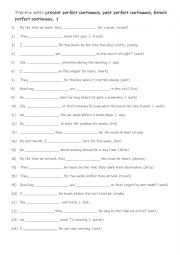
|
B1-B2 Practise with present perfect continuous, past perfect continuous, future perfect continuous. 1
Mastering the present perfect continuous, past perfect continuous, and future perfect continuous tenses allows students to express actions with a focus on duration, repetition, and time relationships. These tenses enable them to describe ongoing activities, show the cause and effect of past actions, and convey future intentions with precision. By u...
Level: intermediate
Age: 11-100
Type:
Downloads: 102
|
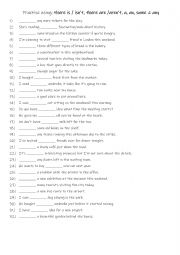
|
A1+-A2 Articles and quantifiers Practise using there is / isn�t, there are / aren�t, a, an, some & any
Learning the structures "there is / isn�t", "there are / aren�t", "a / an", "some", and "any" is essential for clear communication in English. They help students describe the existence or absence of things, specify quantities, and form both positive and negative sentences. "A" and "an" are used for singular, countable nouns, while "some" and "a...
Level: elementary
Age: 8-100
Type:
Downloads: 106
|
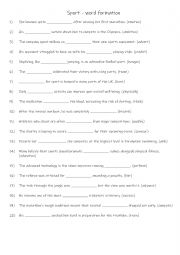
|
B1+ Sport - word formation
Understanding word formation allows students to expand their vocabulary, enabling them to express themselves more precisely and creatively. Knowing how to manipulate words helps them create varied sentence structures, making their writing more engaging and dynamic. Mastering word formation is key to achieving higher levels of language proficiency, ...
Level: intermediate
Age: 9-100
Type:
Downloads: 129
|
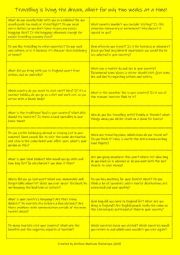
|
Travelling is living the dream, albeit for only two weeks at a time!
This is a thought provoking, speaking activity sheet for students within B1-C1 levels. It looks at different aspects of travelling with some humour and both positive and negative aspects.
My recent C1 class in London took 90 minutes to complete this sheet.However, you will need to change any angles relating to England to your own country for it t...
Level: intermediate
Age: 16-100
Type: worksheet
Downloads: 284
|
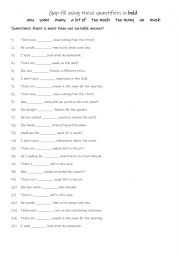
|
A1+-A2 Gap-fill using these quantifiers in bold: any, some, many, a lot of, too much, too many, an & much
Students familiarise themselves with the 8 quantifiers in bold. Then they read the sentences to see which quantifier is required to complete the gap-fill. Answers on page 2.
Level: elementary
Age: 8-100
Type:
Downloads: 111
|
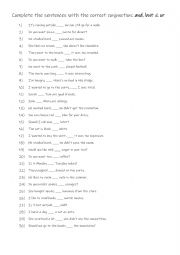
|
Complete the sentences with the correct conjunction and, but & or
Students read the sentences and complete the gap fill with the most suitable conjunction. This worksheet is suitable for A1-A2 levels.Answers on page 2
Level: elementary
Age: 10-100
Type:
Downloads: 108
|
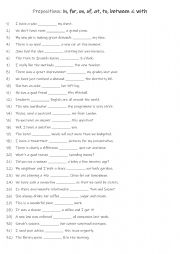
|
A2-B1 Prepositions in, for, on, of, at, to, between & with
Students read the sentences , then complete the gap-fill with a suitable preposition. Answers on page 2
Level: elementary
Age: 8-100
Type:
Downloads: 108
|
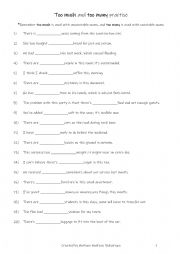
|
Too much and too many practise
Too much and too many practise
Students read the sentences and work out if the sentence needs to be completed with too much or too many.
*Remember too much is used with uncountable nouns, and too many is used with countable nouns
Level: elementary
Age: 10-100
Type:
Downloads: 106
|
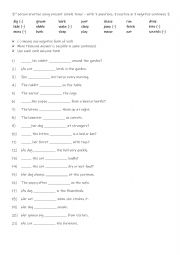
|
3rd person practise using present simple tense � with positive & negative sentences + questions 3
Students familiarise themselves with the 21 verbs. Then they read the sentences to see which question verb is required to complete the gap-fill. Each form is used 7 times! Answers on page 2.
Level: elementary
Age: 8-100
Type:
Downloads: 114
|
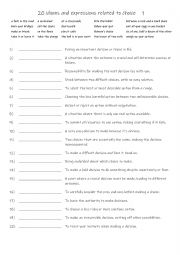
|
B1+-C1 Choice idioms and expressions 1
First, students need to familiarise themselves with the 20 idioms and expressions and their meanings. Then they read the definitions to see which one is being described and write that word in the space provided Answers on page 2.
Level: intermediate
Age: 12-100
Type:
Downloads: 106
|
|
|
|
|












